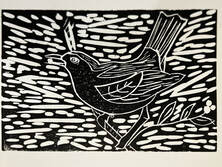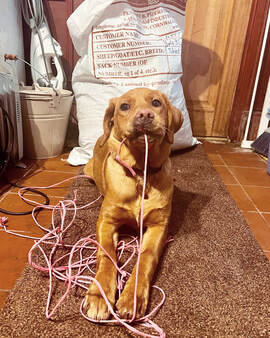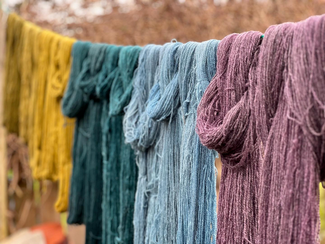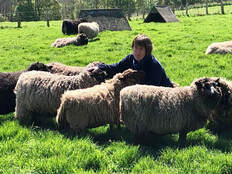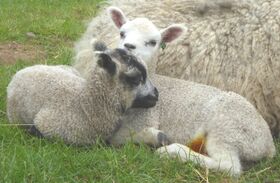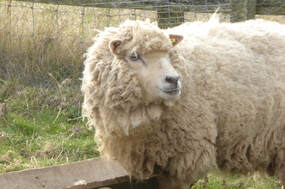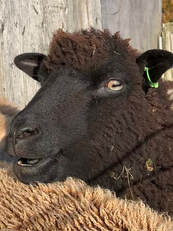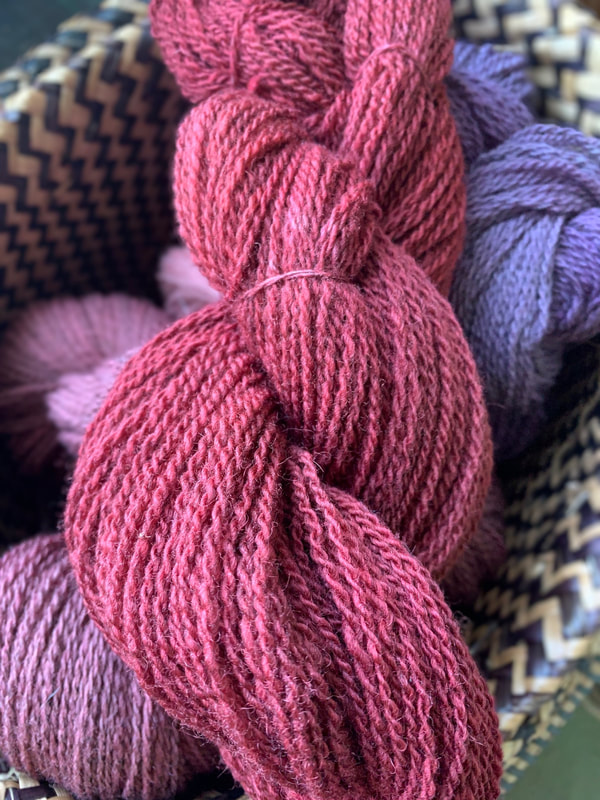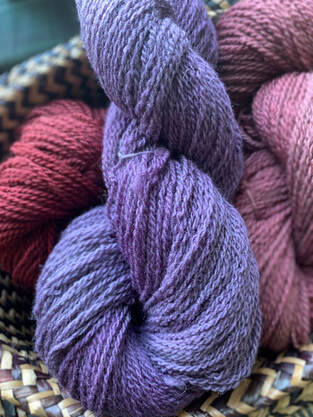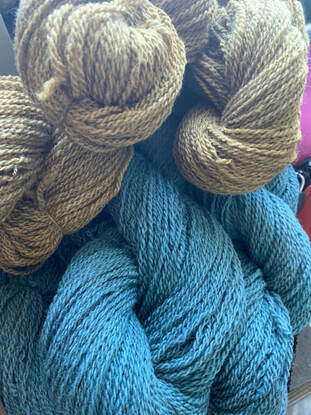|
I love winter - absolutely love it - but I'm not always sure that it loves me as I wish it did.
Many of you will now that - in best sheep-keeping tradition - I flit between five main 'jobs' trying to keep things afloat. However, from March to October each year, our calendar also takes in yarn shows around Scotland and Northern England, and the preparation for these is hugely demanding (physically as well as mentally). Even thought the events are exhausting I still believe that there is no better way of engaging with customers, finding out what they like and seeing what they've made! The full-on nature of it all though means that - in 24/25 I'll be trying to take a proper break from wool shows from October through to March, and perhaps closing the online shop for a month although (like this year) I'll still be answering email enquiries and sending out specific requests. I've now re-opened the shop after a January break for stock-taking, but stocks are still quite low while I wait for spun yarn to come from the Mill ready for this year's shows. See the News Page for info. It's all part of my bid to make my winters more restorative, creative and reflective, so that I'm better equipped to keep my other jobs on the boil and to have more energy for 'the wool season'. This year I'll be sixty. As a treat to myself, I promised myself three creative workshops (not wool business related) over the winter. The first was a lino-cut printing workshop At Birkhill House which I'm officially adding to my list of Happy Places. End result of three hours of fun was the print above of which I am inordinately proud. The second is a needle-felt pictures workshop by Moy Mackay, and the third a taster in stained glass. The sheep have been doing very well over the winter - despite the endless cycle of storms and a period of freezing weather and snowfall. We have acquired two new members of the flock (a three-legged young moorit wether, already called Stumpy when we got him, and a pretty white ewe called Snowy). Both are as friendly as anything, and we'll be looking to buy in some more stock this year as some of our ladies are now quite old and their fleeces do deteriorate over time. We have acquired a puppy, and it's fair to say that this has also been part of the reason for needing a rest. What an all-encompassing, full-of-love-and-chaos period it has been. She's called Rosie, and I'll put a photo below as she has made herself part of the wool-production team! Have a great 2024 everyone! My first blog post of the year! Must do better ...
We've had most of our 2022 fleece clip back from the spinning mills now. Natural Fibre Company in Cornwall really went the extra mile for us this year and turned around two fantastic new yarns: a new (still to be named!) mid-grey DK which we'll keep under wraps until later in the summer, and a beautiful steely grey 4ply called Shaela which we launched at the Scottish Wool Producers' Showcase in Perth and which is now available in our online shop. It's wool-spun, lofty and full of bounce, and has even been described as 'incredible' by one happy customer. I've written here before, and on my IG feed @lammermuirwool about my occasional struggles with mental health (depression and anxiety). One of the hard things about it is that it stops me doing things that I love doing: they become insurmountable challenges. Hand-dyeing my wool became one of those things I couldn't bring myself to do. (The sheep are always a great source of strength and happiness though.) At the Wool Producers' Showcase, I was on the next stand to my friend Sue at Hawkshaw Sheep. She hand-dyes the most beautiful skeins of yarn, and I found I was forever sending customers to her stand next door for great colours. I'm always happy to do that, but seeing the lovely shades on her 'wall of wool', reminded me of how much I love creating colour. So, I've been back at the dye pot! I can only dye four 100g skeins at a time, so it's definitely a small batch and time-consuming process, with results which are difficult to replicate despite note-taking. I've been dyeing up the new unnamed grey DK, as well as some white and grey worsted-spun 4ply which was spun up in Huddersfield. I'm in love with the colours! I spend a lot of my free time (in betweeen four jobs) taking photos of colours that inspire me in my local landscape and on trips around Scotland. It's great when the colours emerge from the dye-pot just the way I'd hoped. And if they don't? Then it's time to get my thinking head on and dye them again! We've now been accepted for the seven yarn events we've applied for this year. Deciding which events to apply for is a thoughtful process and the applications take time and more careful thought! We have limited ourselves to a smaller number of events this year, three in Northern England and four in Scotland. There can be a real FOMO which used to lead us to chase as many events as possible, but we know which ones work best for us now, and we like to put the time in to launch new products and prepare knitted samples. See the events we are attending in 2023 here. And finally, I've been finishing off last year's accounts, and I think (like many other vendors) we are going to have to give serious thought to putting up our prices. Our two main costs each year are Production (getting fleeces spun), and stall fees at events. Both of these costs have had to rise (like everything else) and I can't really absorb those costs any longer. Hand-dyeing wool is very costly and energy consuming (I might not have noticed this before as I haven't dyed anything since 2019!) using masses of hot-water. We've always made a point of trying to keep our yarns affordable as I know many of our customers are struggling too! However, we will continue to offer bulk-purchase discounts at events (for those of you buying more than 500g of one yarn) and I'll look again to see if this can be done on the website also. So, we'll be looking at a wee upwards adjustment from 1st June with the main difference likely to be in the cost of the hand-dyed yarns. Plenty of time to order before then! Hope you are all having a good spring. As you can see from the photo above, we currently have absolutely no shortage of grass, and the ewes are in great condition. Perhaps too great! With no lambs, the ewes have had no additional demands on them over the winter, reflected in their condition.
We are having the usual few weeks of anxiety about fly-strike, and cast sheep, before the shearer comes in a couple of weeks time, then it will be a relief to the sheep and to us to get them sheared of their heavy fleeces and protected against blowflies and ticks. We've updated our website, so you can see which shows we've applied to this year and it will be really good to see some of you in person. I've been lucky enough to get hold of an additional 17 top-quality white Shetland fleeces from a neighbouring farmer, and these will be added in to the 2022 clip. There are really so lovely and soft. It means we can get some additional lace-weight yarn spun. Stocks of lace-weight have been disappearing out of the door at a rate of knots after the yarn was featured in a beautiful shawl pattern in Knitter magazine. Designing patterns is way beyond my skill-set, but I'm acutely aware that buyers need to be be able to see how any given yarn knits up, and its possibilities! The 2021 clip is currently away at the mill and we are looking to get another batch of pale-grey DK, added to our shop as soon as we can. We'll keep you posted! ... and so is the snow! Just a quick blog post to remind you all that we will be at the Scottish Wool Producers' Showcase, at the Station Hotel in Perth this coming Saturday 2nd April. We've been posting on social media about our preparations, and we hope to see you there.
Really looking forward to launching our new custom-dyed lace-weight yarn (available in 50g+ 'cakes') at the event, and thereafter on our website! Am currently knitting a shawl in the blue 'Lammerloch' shade - it's lovely! We know that Royal Mail is putting its charges up in the coming weeks, so we'll need to update our charges to take account of that. We'll also need to review our pricing over all, and make a few small upward 'adjustments'. As always though we are committed to trying to keep our yarn as affordable as we can. I'm also trying to find a way of offering online discounts for 'bulk' purchases, as we do at Shows, but am struggling with the software a bit! After ten days of real warmth and some welcome sunshine, it's been back to winter weather the last few days with snow showers and sub-zero temperatures. The sheep are well able to cope with the cold, and their fleeces feel great! Hope you are all keeping warm. It's too long since I wrote a blog post, but COVID-derived ennui and then ill-health has really had me take my eye off the ball.
After eighteen months of no real yarn events, it was so so good to exhibit in person at Perth Festival of Yarn and then at Yarndale in Skipton. Both events were incredibly well-organised and felt very COVID-safe. Perhaps because of this, coupled with people's sheer happiness at being able to attend and spend, both of these events were amongst the busiest we have ever been at. We were worked off our feet and we were so happy to see people buying sweater-amounts of yarn. Thank you so much to the organisers and to everyone who came along and supported our stand. It means a lot. Thanks also to everyone who has bought from us online over the last year or so - you really did help us to keep going! I'm starting to get my woolly mojo back and will be starting to dye yarn again soon, as the online shop is starting to look a bit bare! In the meantime, we have our 4 shades of commercially dyed yarn: Glengairn, Millbrae, Gean and Lammerloch available both in DK and in 4 ply. We have some dyed lace coming soon, and this will be available in four shades, in 50g and 100g skeins. We'll do an email out to our mailing list members when it's available. Our woolly flock is looking good as winter approaches. We made the decision last year to downsize the flock quite considerably with three starter flocks heading to Aberdeenshire and one to Fife. We have stopped lambing for the foreseeable, which means that we will no longer have to rear tup lambs to get slaughtered at 16 months. This is partly because we lost a good bit of our grazing last year, but it also makes life a lot simpler. The impact of this on our flock's fleeces has been visible very quickly - the fleeces are stronger and softer, and the ewes are all going into the winter in great condition. We've had a couple of bouts of snow already, which is usual for here. The sheep are very skilled at finding the best places to shelter out of the prevailing wind, and haven't blown away yet! The photo shows Koru Jot, a bonny white ewe but perhaps the most stubborn member of the flock! Hope you are all managing to stay warm. Although we would never want to tempt fate, after the last few months which have seen a lot of snow, things seem to be warming up and we have even seen some new grass growth in the fields.
We have down-sized our flock quite considerably over the last 9 months or so, and now keep a small collection of ewes of all ages, for wool production. Ewes have been sold to new homes - all of them to brand new shepherds and smallholders around Scotland, and we wish them lots of luck with their very friendly sheep! The ewes have been getting their usual winter rations of ad-lib hay (which they love), some hard feed and mineral supplements both as a drench and in lick-bucket form. However, for our ewes, nothing beats grass and we've always noticed how they'll dig down through the snow to find it if they can. The ewe in the photo is our oldest, Birgitta and she is 9 this year, and showing no signs of slowing down. She was the first lamb born when we moved to this holding from our previous one, and is therefore sheep number 0001. And she knows it! Leading the other ewes in any bad behaviour that's going on she is always the sheep who thinks that our instructions and exhortations don't apply to her. And we love her to bits. Like most of you, we have been in full lock-down since Boxing Day, and it's fair to say that the sheep have been a great source of comfort over that time. In terms of woolly news, we have a few bags of fleece just ready to go off to the spinning mill, and we'll be looking to get more of the pale/mid grey (currently Haar DK in our shop) as it works so well as both a natural and a hand-dyed shade. It will be a few months before we see the end-result but hopefully in time for Virtual Woolfest in June. I've been taking a bit of time out of the business side of things (apart from posting out orders), due to illness, but hoping to be raring to go again soon, and getting ready to see everyone (even if only virtually for now) at woolly events this year. Need to get some nice woolly items knitted up in both the Ree and the Moorit DK, so always on the lookout for ideas and inspiration! Best wishes to you all. Welcome to early autumn; a time of rich colours and harvesting. Farm harvesting now finished in the fields around the house, but plenty wild harvest or foraging in local hedgerows still to be done.
It has been a busy time with the sheep, too. We made the decision to downsize our breeding flock by about 50%, and have sold many of our best-loved sheep to new breeders looking for small starter-flocks of their own. It's a sad thing to do, but we are happy that they are all with loving new owners who will get as much joy from them as we have. The last of the tups was sent to the abbatoir in early October and the meat should be back with us soon. As far as wool goes, we got the commercially dyed cones back from the dyer and discovered that they need further scouring before we can sell them, so they need to go back to the mill. We have managed to scour a limited amount of DK and 4ply by hand, and this will go up on our website tomorrow (24/10), in time for this year's Kendal Virtual Wool Gathering. The Gathering is being run via their Facebook Group and this is where all the vendors will be posting their wares, demonstrations and talks available and announcements made. Please click on the text link and join up to the group! We will also be running some special discount codes over the weekend (launched in the group and to our newsletter subscribers) and you will be able to watch the You Tube Video we made in the summer. A year without face to face wool shows has been hard; partly because of the impact on income, but also because we love meeting new and returning customers in person, sharing knitting plans or photos of work completed and our love of our animals and their wool. It might be that 2021 brings much of the same as this year, and so virtual wool events (and perhaps even a more regular blog and newsletters) might become the new usual. Of course, the Covid pandemic continues and we are currently in a state of semi-lockdown which is likely to be tightened over the coming weeks. Luckily at the moment I can still meet with one friend at a time for walks or to sit in a cafe and catch up. The sheep are a blessing, as is being surrounded by lovely wool all waiting to be made into nice things over the coming months. Wherever you are, I hope you are keeping well. 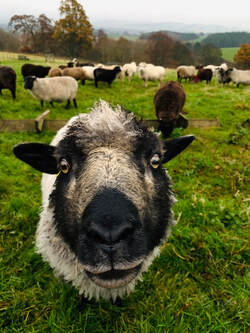 The sheep are doing great despite the hot weather. We've a couple of batches due to go off to pastures new (new owners setting up their own flocks) as we need to downsize a bit. We tried to have a couple of picnics at the field while we were spending days there working, but they didn't always work out as planned as the sheep tried to mob us for our sandwiches. Prime offender was Tille (left). She's fearless. The sheep are not yet sheared; we were tempted to start a couple but - despite recent good weather - the rise just isn't there in the fleece yet. The rise is a natural thinning of the fleece and when we handshear, we aim to cut along the rise and above any new growth. This makes the fleece much easier to process. Machine shearing tends to run along the skin of the sheep, removing both the older fleece and any post-rise growth, leaving a fleece with a weakness in the staple. As we have not lambed this year, our rise might be later - the ewes just haven't had the same demands on them physically as they would if supporting/feeding lambs. We cannot treat the sheep with any anti-fly treatments until after shearing, so we have to be alert for flies laying their eggs in the rise of the fleece (a nice moist warm place for them to choose) and the risk of flystrike. Regular checking is essential and it is always a relief to get the sheep sheared and treated. We'll have fleeces - straight from the sheep - available for sale soon. Contact me if you are interested. As far as wool dyeing goes, I've made a start on dyeing some of the new DK yarns we've had in. After trials, it's only really the Haar DK which is light enough to take a dye and I've managed to produce these stunning shades. I absolutely love them and need to dye some more for myself to knit with! In terms of the yarn which is away at the dyers, progress has obviously been halted due to lockdown, but hoping to have some back ready for Woolfest in June. Really looking forward to it!
I'm not about to launch into lots of lockdown musings: there've been times when I've really struggled with the lack of freedom to be 'out' and seeing friends although the first few weeks were fairly calm and positive. What I had thought was a lockdown 'fuzzy head with tiredness', or perhaps the return of depression turned out to be the most common 'very common' side effect of some new tablets I'd been prescribed *face palm*. Like lots of others, I've been trying to rediscover pleasure in small things and stay connected. Stay well, all of you |
Archives
January 2024
Categories |
Proudly powered by Weebly

